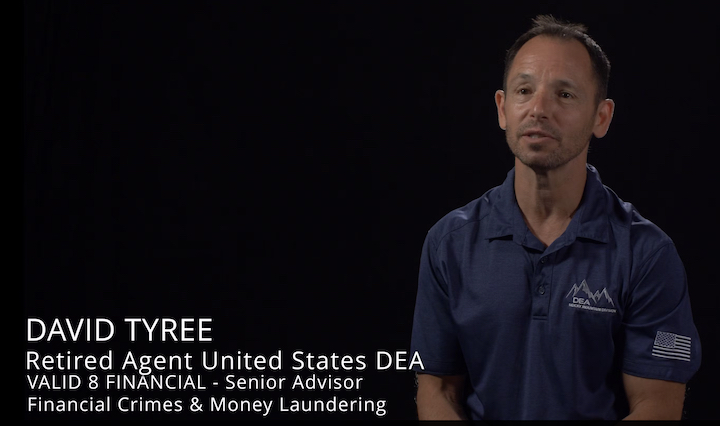The Evidence Ledger
Investigating Elder Financial Abuse: Where Law Enforcement Meets Forensic Intelligence

Elder financial abuse is a silent epidemic — one that often hides in plain sight, masked by small-dollar transactions, fractured relationships, and misplaced trust. To investigate these crimes effectively, two skill sets must come together: the investigative instincts of law enforcement and the meticulous analysis of forensic accounting. In this Q&A, Valid8 Senior Advisor and retired DEA agent David Tyree joins Valid8 Co-Founder and forensic accounting expert Tod McDonald to examine how these cases unfold—and how technology is making a difference.
Q: What makes elder financial abuse so uniquely difficult to detect and investigate?
Tod McDonald:
There’s this perfect storm: declining cognition, loneliness, generational trust, and easy access to financial assets. I’m going through it personally with my parents—not as victims, thankfully, but I see how vulnerable they are to everything from phishing to pressure from distant acquaintances. The hardest part? Distinguishing what may simply be unusual from the truly suspicious.
David Tyree:
Additionally, guilt shame, and embarrassment keep people from reporting it. You’re dealing with victims who often don’t realize they’ve been scammed—or they’re too proud to admit it. And when the perpetrators are family members or caregivers, it gets even harder to spot and prosecute. I once saw a case where law enforcement approached a victim’s home and tried to return stolen funds, and the victim—convinced they were being scammed again—opened fire on the responding officers.
“Elder financial abuse is a silent epidemic—costing victims billions each year, yet often hidden behind small, frequent withdrawals and the illusion of trust.” — David Tyree
Q: How do most elder financial abuse investigations get started?
Tyree:
Usually, it’s a family member who flags something—often after a weekend visit. You’ll also sometimes see suspicious activity reports (SARs) come through from financial institutions, but they can be hard to act on without a deeper financial trail. Increasingly, I’m also seeing referrals from crypto recovery firms trying to trace what happened after funds were transferred to kiosks or wallets. In all of these, telling a clear financial story is key to prosecution and recovering funds.
McDonald:
Depending on who is bringing us in, forensic accountants don’t always know when a case relates to elder abuse specifically—law enforcement or regulatory agencies don’t always disclose that. But how the investigation gets started is consistent: someone needs to understand where the money went, and when.
Q: Once the case is open, what are you both looking for in the financial records?
McDonald:
Step one is access—getting bank statements, check images, and account data. In elder abuse, this can be tricky because victims may not use online banking or may still receive paper records. Once we have that, it’s a matter of looking for suspicious patterns within mountains of data. That’s where a tool like Valid8 is incredibly helpful. All of the financial data is uploaded. Valid8 ingests and reconciles it. The platform automatically flags missing statements, isolates recurring transactions, and surfaces patterns—like frequent ATM withdrawals or suspicious checks to caregivers. That’s weeks or months of manual labor condensed into just a few hours.

Tyree:
From the investigative side, we’re also looking for patterns but for a different purpose. We try to determine whether the transactions are consistent with the victim’s behavior, or whether someone else is behind them. Unfortunately, just like the work that forensic accountants do, that often means stacks of paper records piled on the desks of an already overwhelmed investigative team. Law enforcement use Valid8, too. We don’t have to be accountants – the platform helps us cut through the data overload—by clearly showing what happened, when, and how.
Q: Why is it so critical to reconcile every transaction in these cases?
McDonald:
Because the abuse often doesn’t come from a single wire—it’s death by a thousand withdrawals. $40 here, $100 there, over months or years. And you have to look at all of it. If even one month of statements is missing or one account is left out, the whole financial picture becomes unreliable. And without that completeness, your conclusions fall apart in court.
Tyree:
Exactly. The burden of proof is on the investigative team. If the numbers don’t add up—or if there's even a small error—the entire case can collapse. Whether it’s a domestic prosecution or something involving international wire transfers, everything must be bulletproof.
Q: How does the collaboration between law enforcement and forensic experts play out in these investigations?
McDonald:
Forensic accountants are often either embedded within agencies or brought in from outside firms. Their role is to structure the data—reconcile, validate, and identify irregularities. But we’re not always the ones making charging decisions. That’s where the law enforcement side takes over.
Tyree:
Right. It’s like Tod is doing the heavy lifting of filtering signals in a room full of noise, and I’m trying to find a signal I can act on. We’re both trying to understand the same story—we just look at it from different angles. But unless the financial evidence is clear and organized, we risk losing key elements to legal motions or courtroom confusion.
Q: What kinds of elder abuse show up in the data — and how are they different?
McDonald:
There’s personal exploitation—family members with joint access or power of attorney slowly draining accounts. Then there’s more organized fraud: romance scams, impersonation calls, Bitcoin kiosks. The latter tend to have clearer financial trails, and the family cases are often harder to detect because they blend into normal spending.
Q: How do prosecutors decide which cases are worth pursuing?
Tyree:
First question is always: “What was the loss?” If it’s under a certain threshold, it might not justify the time and resources. But when we can show six-figure losses—or show that a $30,000 case is part of a larger fraud ring—that changes the game.
But victims aren’t always willing to testify against loved ones. That’s a major barrier. Add in the fact that many are older, vulnerable, and traumatized—it’s a long road to prosecution. But if we can isolate transactions by actor, or show a change in spending behavior over time, that builds credibility and makes it more worth pursuing.
Visualizations from tools like Valid8 help us tell that story quickly and compellingly.

Q: What advice would you give to investigators or forensic teams new to elder abuse cases?
Tyree:
Don’t give up. Bank records don’t lie. When memories fade, victims go silent, or stories change, the financial data still tells the truth. Let that guide you. When bad actors know there are tools that will trace their activity, it makes them think twice. We can’t stop every scam, but we can make these crimes harder to commit—and easier to prosecute.
McDonald:
Same goes for forensic teams—don’t chase the narrative, chase the evidence. Nail the micro before you try to tell the macro story. Once the data is complete and reconciled, it’ll speak for itself.
Want to go deeper?
Whether you’re investigating suspected elder abuse, reconciling fragmented records, or surfacing hidden patterns among volumes of small-dollar transactions, Valid8 helps you turn disorganized data into actionable evidence. Contact us to learn how Valid8 supports law enforcement, forensic experts, and protective service teams in building stronger financial cases—faster.
Tod McDonald, CPA, CIRA, is the co-founder of Valid8 Financial. Early in his career, Tod was an auditor with Ernst & Young and has spent decades navigating complex financial situations, including leading an investigation that unraveled a $200 million real estate investment Ponzi scheme in Washington State. Motivated by this experience, he co-founded Valid8 Financial to build a Verified Financial Intelligence solution to expedite data prep, eliminate sample risk and improve the speed and quality of rendering a professional opinion on complex financial cases.
David Tyree is a 25-year DEA veteran and expert in financial crime, asset forfeiture, and anti-money laundering. He has led major investigations resulting in over $80 million in seized assets linked to drug trafficking, human trafficking, and organized crime. As Senior Advisor at Valid8 Financial, he helps law enforcement understand how to use technology to turn complex financial data—from bank records to crypto—into courtroom-ready evidence. David is ACAMS-certified and has served in key investigative roles across the U.S. and internationally.


















